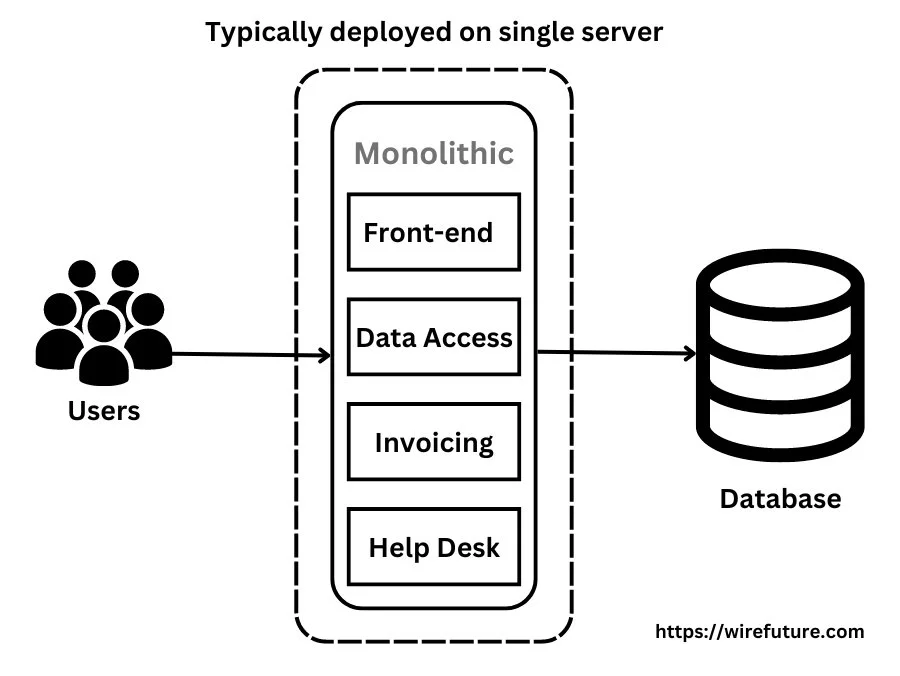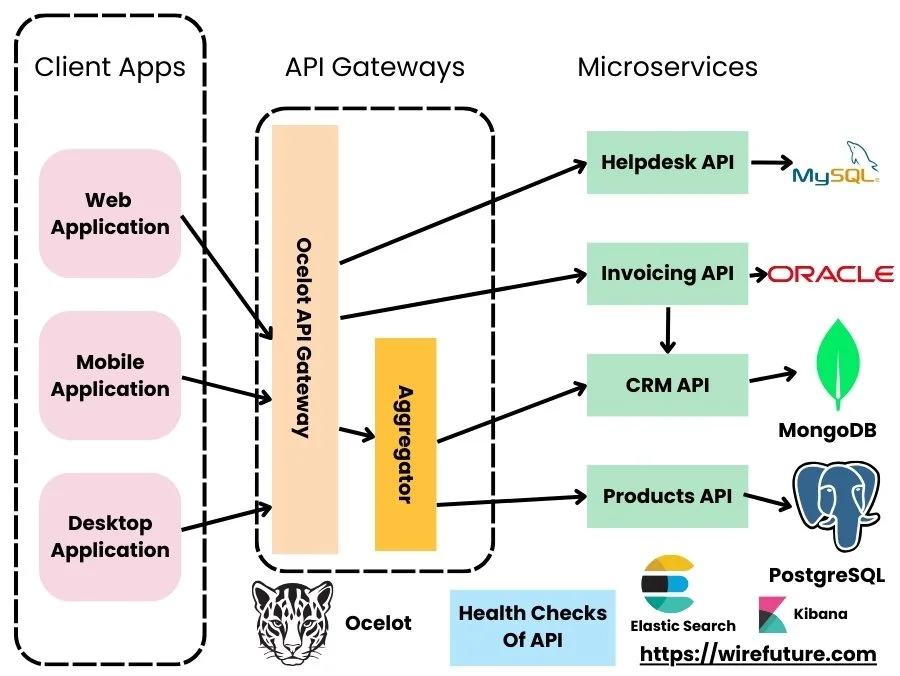Microservices vs Monolithic Architectures: Which to Choose?

In the quickly changing software development environment, developers and architects frequently reach a crossroads when selecting the appropriate architectural pattern for their applications. Two prominent paradigms are microservices and monolithic architectures. Both have advantages and challenges and choosing one can make or break a project. In today’s blog post, we will study Microservices vs. Monolithic Architectures, delving into their pros and cons, and provide guidelines to help you choose the right approach for your next project.
Optimize your application architecture with WireFuture! Whether you’re considering microservices or monolithic, we provide expert guidance and solutions tailored to your needs.
Table of Contents
- Introduction
- Microservices vs Monolithic Architectures: Understanding Monolithic Architectures
- Understanding Microservices Architecture
- Comparing Monolithic vs. Microservices Architectures
- Microservices vs Monolithic Architectures: Choosing the Right One
- Conclusion
Introduction
When I first began working as a software developer, breaking an application into smaller workable parts was exciting yet frightening. The thrill of having independent services communicate promised a great deal of flexibility. But the monolithic approach with its simplicity and straightforward development process was also attractive. I’ve spent countless hours debating which architecture to use for different projects. And now I share my insights and experiences with you.
Have you ever been in a situation where you had to choose between microservices and monolithic architectures? How did you feel about making that decision? Let’s explore these architectures together and see what fits best for different scenarios.
Microservices vs Monolithic Architectures: Understanding Monolithic Architectures
What is a Monolithic Architecture?

A monolithic architecture is a traditional model where all components of an application are integrated into a single, unified codebase. This includes the user interface, business logic, and data access layers. Everything is packaged and deployed as a single unit.
Pros of Monolithic Architecture
- Simplicity: A monolithic application is simple to develop, test, and deploy. All components are in one place, making it easier to understand and manage.
- Performance: Inter-component communication is fast because everything resides within the same process.
- Development Speed: For small to medium-sized applications, development can be faster because there is less overhead in terms of inter-service communication and coordination.
- Easier Debugging: With all components in one place, it is easier to trace and debug issues.
- Deployment: Deployment is straightforward since there is only one unit to deploy.
Cons of Monolithic Architecture
- Scalability: Scaling a monolithic application can be challenging. You must scale the entire application, even if only one part needs more resources.
- Flexibility: Monolithic applications can become rigid and difficult to modify as they grow. Changes in one part can impact the entire system.
- Maintenance: Over time, the codebase can become large and cumbersome, making maintenance difficult.
- Deployment Risk: A small change requires redeploying the entire application, increasing the risk of downtime.
Understanding Microservices Architecture
What is a Microservices Architecture?

Microservices architecture is a modern approach where an application is composed of small, independent services that communicate over well-defined APIs. Each service is responsible for a specific piece of functionality and can be developed, deployed, and scaled independently.
Pros of Microservices Architecture
- Scalability: Services can be scaled independently based on demand, leading to more efficient use of resources.
- Flexibility: Each service can be developed using different technologies and frameworks, allowing for greater flexibility.
- Resilience: Failure in one service does not necessarily affect the entire application. Services can be restarted independently.
- Faster Deployment: Independent services mean that updates and new features can be deployed without impacting the entire system.
- Maintainability: Smaller, focused codebases are easier to manage and maintain.
Cons of Microservices Architecture
- Complexity: Managing multiple services increases the overall complexity of the system. It requires robust DevOps practices and tools.
- Communication Overhead: Services need to communicate over the network, which can introduce latency and require efficient API management.
- Data Consistency: Maintaining data consistency across services can be challenging, especially in distributed systems.
- Testing: End-to-end testing can be more complex as it involves multiple services and their interactions.
- Deployment: While microservices can be deployed independently, managing deployments across multiple services can be intricate.
Comparing Monolithic vs. Microservices Architectures
To better understand the differences between monolithic vs. microservices architectures, let’s compare them side-by-side.
| Feature | Monolithic Architecture | Microservices Architecture |
|---|---|---|
| Scalability | Difficult to scale individual components | Easily scalable, services can be scaled independently |
| Development Speed | Faster for small to medium-sized applications | Slower initial development due to complexity |
| Complexity | Lower, single codebase | Higher, multiple services to manage |
| Flexibility | Less flexible, tightly coupled components | Highly flexible, can use different technologies |
| Deployment | Single unit, easier but riskier | Independent deployments, safer but more complex |
| Maintenance | Harder as the codebase grows | Easier with smaller, focused codebases |
| Resilience | Less resilient, single point of failure | More resilient, failure in one service doesn’t affect others |
| Communication | In-process, faster | Network-based, can introduce latency |
| Data Consistency | Easier to maintain | More challenging, requires robust strategies |
| Testing | Easier to test as a whole | More complex, involves testing multiple services |
Microservices vs Monolithic Architectures: Choosing the Right One
Choosing between microservices vs monolithic architectures depends on several factors. Here are some guidelines to help you make an informed decision:
When to Choose Monolithic Architecture
- Small to Medium-Sized Applications: If your application is small to medium-sized, a monolithic architecture might be simpler and quicker to develop and deploy.
- Tight Deadlines: When you have tight deadlines, the simplicity of a monolithic architecture can speed up development.
- Limited Resources: If your team has limited resources and expertise, managing a single codebase might be more feasible.
- Less Complex Domain: If your application domain is not overly complex and doesn’t require extensive scaling, a monolithic approach might be sufficient.
When to Choose Microservices Architecture
- Large-Scale Applications: For large-scale applications that require high scalability and flexibility, microservices are a better fit.
- Independent Scaling: When different parts of your application have varying scaling needs, microservices allow you to scale services independently.
- Heterogeneous Technologies: If you want to use different technologies for different parts of your application, microservices provide the flexibility to do so.
- Continuous Deployment: If you require continuous deployment and frequent updates, microservices enable independent deployments without affecting the entire system.
- Resilience and Fault Isolation: For applications that need high resilience and fault isolation, microservices ensure that failures in one service do not impact others.
Conclusion
The selection of the best architecture for your application is a crucial decision which impacts its performance, scalability and maintainability. Monolithic architectures offer simplicity in addition to faster development for smaller projects while microservices offer flexibility, scale and resilience for larger, more complex applications. Knowing the advantages and disadvantages of each approach and your particular requirements will enable you to make the correct choice on your project.
In retrospect, have you ever had a problem with either architecture? How did you overcame them? Share your thoughts and let’s continue the conversation.
Reach out in case you have questions or require further help. Your feedback and experiences help make this journey a much better one for everybody. Have fun coding!
Imagine a team that sees beyond code—a team like WireFuture. We blend art and technology to develop software that is as beautiful as it is functional. Let's redefine what software can do for you.
No commitment required. Whether you’re a charity, business, start-up or you just have an idea – we’re happy to talk through your project.
Embrace a worry-free experience as we proactively update, secure, and optimize your software, enabling you to focus on what matters most – driving innovation and achieving your business goals.




